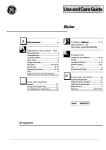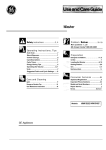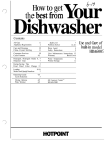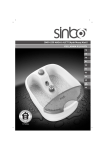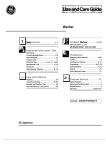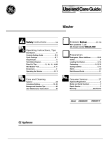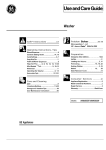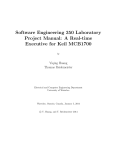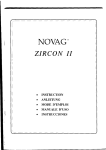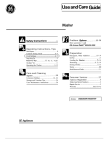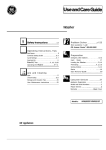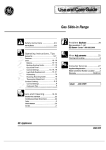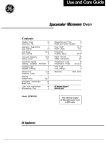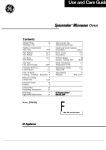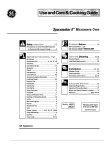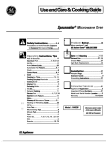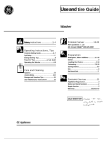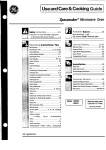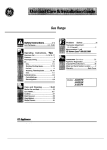Download GE WWA7600S User's Manual
Transcript
Washer
Problem Solver.......................l5-l9
Safe~ instructions....................3, 4
More questions ?...call
GE Answer Center@ 80~626.2000
Operating Instructions, Tips
Bleach Dispenser ..............................,............7
Control Settings..............................................6
Cycle Descriptions .........................................5
Cycle Times .....................................................6
Energy-Saving Tips ........................................7
Fabric Softener Dispenser ...........................7
Operating the Washer......................,.......6,7
Suggested Fabric and Cycle Settings .......8
Care and Cleaning
Agitator . . . . . . . . . . . . . . . . . . . . . . . . . . . . . . . . . . . . . . . . . . . . . . . . . . . . . . . . . . 19
Storage and Vacation Tips . . . . . . . . . . . . . . . . . . . . . . . . 19
User Maintenance Instructions . . . . . . . . . . . . . . . . 19
Preparation
Detergents and Additives ...................l1, 12
Hard Water . . . . . . . . . . . . . . . . . . . . . . . . . . . . . . . . . . . . . . . . . . . . . . . . . . . . 11
Loading the Washer ...............................6, 10
Sorting Clothes ..........................................6, 9
Stains . . . . . . . . . . . . . . . . . . . . . . . . . . . . . . . . . . . . . . . . . . . . . . . . . . . . . . . . . . . . . . 12
Stain Removal Guide ..................................I4
u
‘@
Consumer Services ..................23
Appliance Registration .................................2
Important Phone Numbers .......................23
Model and Serial Numbers ..........................2
Repair Service .................................................2
Warranty ........................................Back Cover
Model.
GE Appliances
WA7600S
~LP US mLP YOU...
Read this book carefully.
Save time and money.
It is intended to help you
operate and maintain your
new washer properly.
Keep it handy for answers to
your questions.
If you don’t understand something
or need more help, write (include
your phone number):
Consumer Affairs
GE Appliances, Appliance Park
Louisville, KY 40225
Before you request service . . .
check the Problem Solver
section. It lists causes of minor
operating problems that you can
correct yourself.
To obtain a Spanish language
version of this book, call
GE Answer Center@
800.626.2000
consumer information service.
If you received a
damaged washer...
Immediately contact the dealer (or
builder) that sold you the washer.
Para obtener la versi6n en
espafiol de este manual, name a
GE Answer Center”, servicio de
inforrnaci6n para el consumidor,
te16fono 800.626.2000.
Write down the model
and serial numbers.
You’ll find them on a label on
the lower left side near the front.
These numbers are also on the
Consumer Product Ownership
Registration Card that came with
your washer. Before sending in
this card, please write these
numbers here:
Model Number
Serial Number
Use these numbers in any
correspondence or service
calls concerning your washer.
WW~G:Foryoursafety theinformationin thismanud must be fo~owedto ‘*
tie tik of fm or e~losion or to prevent property darnag~ personal injury or loss of Me.
●
—h not store or use gasotie or other
tible vapors and tiquids in the
ticirdty of t~ or any other appbce.
—-T TO ~ W YOU S~LL GM
M not try to Eght my appliance.
* Do not touch any electrid switch;
da not we any phone h your btiding.
. ~~ the room, butiding or area ofm
Wupantso
●
I
*ediately ~ your gas supplier tim a
neighbor’s phone. Foflow the gas supptier’s
instrutiom
fiyoa cannot reach your gas supptier$
d the b department
—kMatio~ and service must be performed
by a q-led insta~er, service agency or
the gas suppMer.
●
●
All washing instruction terms in this book conform to the Care
Labeling Rule established by the Federal Trade Commission, January 1984.
If You Need Service
To obtain service, see the Consumer Services page in
the back of this book.
We’re proud of our service and want you to be
pleased. If for some reason you are not happy with the
service you receive, here are three steps to follow for
further help.
FIRST, contact the people who serviced your
appliance. Explain why you are not pleased. In most
cases, this will solve the problem.
2
NEXT, if you are still not pleased, write all the
details—including your phone number—to:
Manager, Consumer Relations
GE Appliances, Appliance Park
Louisville, KY 40225
FINALLY, if your problem is still not resolved, write:
Major Appliance Consumer Action Panel
20 North Wacker Drive
Chicago, IL 60606
A
WARN~&To reduce the risk
of fire, electric shock, or ~ury to
persons when using your appiiance,
follow basic precautions, including the foiiowing:
*Use this appliance oniy for its intended purpose
as described in this Use and Care Book.
This washer must be properly
\ + i’i 9
instaiied and located in accordance
w.
with the Wtaiiation Inst~ctions
before it is used, If you did not receive an
●
hstailation Instructions sheet with your
washer, you can obtain one by calling, toll
free, the GE Answer Center? 8W+626.2W.
—hperly ground to conform with ail
governing codes and ordinances. Foiiow
details in ktaiiation ktructions,
—btaii or store wh~re it wiil not be exposed
to temperatures below freezing or exposed
to tha weather.
to a properly rated, protected and sized
power supply circuit to avoid electrical overload.
<onnect to adequate plumbing and drain
facilities as described in the tistdlation
kstructions.
<onnect
●
Turn off water faucets when the washer is not in
use to relieve pressure on hoses and valves, and
to minimize leakage if a hose or valve should
break or rupture.
men disconnecting this appliance
~ pull by the plug rather than the cord to
avoid damage to the cord or junction of
cord and plug. Make sure that tho cord
is located so that it will not be step~ on, tripped
over or otherwise subjected to damage or stress.
* Do not repair or replace any part
M
*
of the appiiance or attempt any
servicing unless specifically
recommended in this Use and Care Book or
in pubiished user-repair instructions that you
understand and have the skills to carry out.
TO mtimize the -ibfiity of i~ury:
●
w
&
Do not mix cMorine bleach with
ammonia or acids such as vinegar an~or
rust remover. -g can produ~ a
toxic gas which may cause deati,
* Do not wash or dry articlw that
have been cleaned in, washed in,
~ / soaked in, orspottedwith
combustible or explosive substances
(such as wax, paint, gasoiine, degreasers, d~cleaning solvents, kerosen~ etc.) which may
ignite or explode. Do not add these substances
to the wash water. Do not use these su~tances
around your washer an~or dryer during
operation,
WARN~&HYDROGEN GAS
is pduced by the ch~micai action
within your water hwter and the gas
can accumulate in the water heater anwor water
pi~’ifhot water has not been used for a wriod
of two weeks or longer. HYDROGEN GAS
CAN BE E=LOS~ UNDER -E
CRCUMTANCES, So to prevent the
possibility of damage or i~ury, if you have not
wd hot water for two weeks or more, or mave
into a residence in which the hot water systim
may not have been used for some time, turn on
ail hot water fauceti and aiiow them to run for
severai minutes before using any electrical
appiianee which is connected to the hot water
system. This wiii ailow any hydrogen gas to
escape. Since the gas is fiammable, do not
smoke or use an open flame or appliance
during this process.
i’i
h
A
s Never reach into washer while it is
moving. Before loading, mdoadi~
or adding clothes, push in the Cycie
Selector knob to OFF position, then
wait until the machine has completely stopped
before opening the iid.
Close supervision is necessary if
this appiiance is used by or near
children. Do not Mow chiidren
to play inside, on, or with this
appliance or any discarded
appiiance. Dispose of discarded appliances and
shipping or packing materiais properiy. Before
discarding a washer, or removi~ from service,
remove the washer lid.
●
(continwdmtipage)
3
m
h fiot operate tis appliance if it is damagd
Keep dl laundry aids (such as
m-ctioning, partiWy disassembled, or has
detergents, bleaches, fabric softeners,
missing or broken parts, including a damaged
etc.) out of the reach of chilbn,
prefembly in a locked cabinet.
cord or plug.
m Observe W warnings on container
Q Never c~mb on or stand on the washer top.
labels to avoid. mrsonti iniw.
* h not wash fiberglass articles in your washer,
Keep the area around and underneath
Skin irritation could result from the r~maining
yow appliances free from the
particles that may be picked up by clothing
accumulation of combustible rnaterids,
.,w
during subs~uent washtir use.
such as lint paper, rags, chemicals, etc.
Q Ths laundry process can reduce
Keep the floor around your appliances claan ~d 4 t \ the flame remdancy of fabrics.
dry to reduce the possibility of sfippi~g.
$ / Toavoid svchamsult, thegarment
● To minirnim the possibility of electric
h manufacturer’s care instructions
shpuld be followod very carefily.
shock, unplug this appliance km the
power supply bfore attempting any
maintenance or cldng (except me
For wsher opmtion
removal and cleaning of the ht filter).
* ~ aot leave wash~r lid up dting cycle.
NO~: Turning the Cycle Selector
bob to an O~position does NOT
This wi~ stop the wash md spin action and
‘ disconnect the applianm from the
~vent completion of the cycle.
* power supply.
●
●
“.
&
●
●
●
Do not-per tith controk.
SAW -E
Regular Cycles—
Permanent Press Cycles—
For most cottons, linens, work and play clothes.
Longer wash times plus deep rinse, spray rinse
and spin provide thorough washing and detergent
removal.
For loads of synthetics, blends andor delicate fabrics.
A cold water cool down helps prevent set-in wrinkles
in permanent press shirts, blouses, dresses and similar
apparel with normal soil.
Handwash System—
Spotscrubber System—
Saves time and energy when washing small loads
of lightly soiled clothes. A special agitator concealed
under the regular agitator washes small and delicate
loads gently but effectively. The Handwash System
uses up to 2470 less water than the regular low water
level selection.
The Spotscrubber cycle uses a special wash cycle and
a highly concentrated detergent solution in a small
amount of water in the Mini-Basket tub.
Rinse water carries away soils and detergent suds and
automatic extra rinse assures complete removal of
detergent.
Optional Extra Rinse Cycle
PreWash Cycle
The option of an extra rinse in the Regular Cycle
helps assure complete bleach and detergent removal
when extra detergent was used or where unusual skin
sensitivity to detergent is a concern.
For use when clothes are excessively soiled.
Provides an agitated soak, and a soak without
agitation, followed by agitation and spin. Washer
must be reset for desired wash cycle.
Knits Cycle—
Extra Cleaning Cycle—
A shorter cycle specially-designed for today’s knits.
An early and long spray rinse cools down fabrics
before the washer reaches maximum spin speed to
help prevent wrinkle setting.
For modern fabrics with heavy or oily soil. Agitation
for a longer time loosens stubborn soils.
Soak Cycle—
Auto Soak Cycl-
Clothes activate in a soaking agent for a short time,
then the water spins out. Washer turns off at end of
Soak Cycle—must be reset for desired wash cycle.
This will add additional wash time on cycles to allow
the detergent to break down excessive soils. After the
Auto Soak is complete, it will automatically move
through the selected cycle.
Delicate Cycle—
Washable Woolens Cycle—
For lingerie and fabrics requiring special care, this
cycle has a gentle wash and a slow spin.
This cycle helps to reduce the need to wash these
fabrics by hand.
Washable Silks Cycl+
Mini-Basket System—
For fine washable silks. Check manufacturers’ care
labels for special instructions.
Uses the Mini-Basket feature. Provides a complete
wash, rinse and spin cycle.
5
HOW TO OPERATE YOUR CLOTHES WASHER
Features and appearances may vary slightly
WARNING—To reduce the risk of fire, electric shock, or injury to persons when using your
appliance, read the IMPORTANT SAFETY INSTRUCTIONS before operating this appliance.
WWA7600S
I
NO flMAL
Fmr
.
●
~
Regular
?,RMPRESS
Peman9nt Press
MED
G:;;E
\
@
y:~H
~
‘MALLm@m”n’E’:mwM
COLD
wARM
Speed
@
T
0
‘
”
WASU
Load S;ze
o
‘N”:~
o
@
‘Knits
LIG”TSO,L
RINSE
HEAW
N08MAL
\
,“,, s,0,,0,,,,,,“s,,0s,,,
s;xc”.,~~..~~~
9
Q
o
Hea~Du~Larg# Capaci~
b.fl,,s~G-s..
e
Setting the Controls
Use the Suggested Fabric and Cycle Settings guide
to help you make the proper selections.
~ Select Wash Spin Speed.
~ Select Water Level.
SMALL: Washer is less than 1/3 full of clothes.
MEDIUM: Between 1/3 and 1/2 full.
LARGE: Between 1/2 and 2/3 full.
~ Select WasMRinse Temperature.
~ Push Cycle Selector knob inandturnclockwiseto
your selected wash setting.
~ Pull Cycle Selector knob
+ START
out to shrt the washer. If
/
“ \ “
you wish to change setting
STOP +
after washer has started, push
3
Cycle Selector knob into stop
the washer and reset to the new
position. Setting can be changed at any time.
Sorting and Loading
Sort clothes carefully by fabric type, weigh[, color
and amount of soil, according to instructions in How
to Sort Clothes section.
● Add measured amount of detergent. See Detergents
section for information on detergents and other
laundry additives.
● Load clothes into wash basket, being careful not
to overload. See How to Load Your Washer section.
●
See Bleach and Fabric Softener Dispenser sections
for instructions in their uses.
● For information on how to use bleaches and fabric
softeners, see Other Laundry Products section.
● Close the 1 id. Washer will fill but not agitate or spin
with the lid open.
●
Cycle Times — Total Cycle Times (Approximate Minutes)
NOTES:
● Total time includes pauses between each phase of the cycle.
● Total time does not include water fill ti roes. Fill times vary
depending on household water pressure and your selected water level.
Perm Press & Knits
~
WWA7600S
25
Regular
37
Soak
12
How to Use the Bleach Dispenser
Use this dispenser with
liquid bleach only.
/
If you prefer to
use powdered
d...
bleach, pour it
into the wash
basket along with
your detergent. Do
%%
not pour p~wdered bleach
into the bleach dispenser.
Measure bleach carefully.
See manufacturer’s instructions.
● Pour measured amount of liquid bleach directly
into bleach dispenser.
● Do not overfill or allow dispenser to oveflow.
Avoid splashing. Undiluted bleach can cause
fabric damage.
● Never pour undiluted liquid bleach directly
onto clothes or into the wash basket.
●
How to Use the Fabric Softener Dispenser
Position the Fabric Softener
Dispenser on the agitator.
● Pour
manufacturer recommended
amount of fabric softener into a
one cup (240 ml) measuring cup.
● Add enough water to fill the cup 1/2 full.
● Pour the diluted softener into the dispenser.
●
The fabric softener will automatically be dispensed at
the proper time.
● Do not stop the washer during the first spin.
This will cause the dispenser to empty too soon.
● Do not use the Fabric Softener Dispenser with
the Soak or PreWash cycle.
● If the dispenser gets clogged, soak it in a solution of
one cup (240 ml) water and one cup (240 ml) alcohol.
●
How to Use the Soak Cycle
●
Soak: Turn the Cycle Selector knob to soak. Start the
washer. Add pre-measured detergent or soak product;
add clothes.
c NOTE: For an extended soak, allow the washer
to fill and agitate for a few minutes to dissolve the
soaking agent. Then push in the Cycle Selector knob
to stop the washer (keep lid closed) and allow to soak
for as long as desired. After desired soak period, pull
out the Cycle Selector knob to complete the cycle.
ENERGY-SAVING TWS
If your clothes and household items don’t look clean and
fresh after washing, you will probably rewash them.. and
that means you’ll waste energy. Remember to sort your
clothes carefully, and load them properly, select correct
cycles, use enough detergent and choose a water
temperature warm enough to relea,se and get rid oj’.voil.
●
Try to wash less often. Save articles of the same
type of fabric until you have a full load.
[f you must wash smaller loads, adjust the amount
of water. Small loads should have lower water levels.
● Always rinse in cold water. The temperature of
the rinse does not affect cleaning.
● Wash in off-peak utility hours. Your local utility
can tell you which are the off-peak hours.
“ Use your washer’s Normal Spin. This will remove more
water during spin, which will shorten drying cycle to
save more energy.
●
7
SUGGESTED FABWC AND CYCLE SETTINGS
Cycle Suggested
For Clothes LoaWabrics such as:
Permanent Press & Knits
●
●
●
Regular
Synthetics
WasMSpin Speed
Normal/Fast
Permanent press, treated cottons,
blends with cottons
Down-filled garments, if machine
washing is recommended*
●
Pillows**
●
Cottons and linens
●
Denims
●
Blankets***
●
Baby clothes (sturdy)
Gentle/Slow
Normal/Fast
Special Instructions
*Down-filled garments
Wash frequently to fluff up the down and retain the garment’s warmth.
WASH SEPARATELY. Wet down gives off an odor which may be absorbed
by other garments. Odor disappears when garment is dry. Treat heavily soiled
areas with liquid detergent or a paste made of water and powdered detergent.
Close zippers. Wash 2 or 3 garments at a time or add towels to balance.
GARMENT MUST BE TUMBLE DRIED.
**Pillows
Pillows are made of different materials—dacron, foam, polyester, natural feather,
and down. MANUFACTURER’ S CARE LABELS MUST BE FOLLOWED
CAREFULLY. If washing is recommended, check pillows for weak seams or
holes and mend, to prevent escape of the filling. Fill washer, add detergent
and agitate for several minutes. Add two pillows at a time to balance load,
Use largest water level.
***Blankets
Fill washer with water; add detergent and allow to dissolve. Add blanket.
WASH ONLY ONE BLANKET AT A TIME. On electric blanket, sew a strong
piece of cloth over plug to protect blanket and washer from damage. Pre-treat
heavily soiled spots with liquid detergent.
8
Sort by Surface Texture
Separate
ro
LINT PRODUCERS—such as terry toweling and
chenille—give up lint.
LINT COLLECTORS—such as man-made fibers and
napped fabrics like velveteen and corduroy—attract
lint. These must be washed separately.
For more information on lint control, see The
Problem Solver section.
ro
In addition to sorting to
reduce lint collection,
it is recommended
that fabrics of similar
construction be
washed together
whenever possible.
Sort by Soil
Separate
Sort by Color
‘eparate
efro’mromefro’mz!~zs~s
It pays to check and prepare
clothes for washing.
● Empty pockets, brush out cuffs,
zip zippers, and fasten snaps,
hooks and buttons.
● Do any necessary mending—rips.
hems, tears.
● Check all items for areas of heavy
soil or stain.
c Remove stains. See Stain
Removal Guide.
● Turn poly knits inside-out to
minimize fabric surface damage.
EXTRA CLEANING
(See Tips to Help You Select
Settings section for instructions.)
See Stain Removal Guide.
See Fabric and Cycle Settin&s guide.
See The Problem Solver section.
Soaking and Pretreating—a good
way to loosen deep soils and stains.
A thorough soaking with detergent
or special soaking agent is another
way to remove heavy soils,
embedded dirt and even some stains.
Soaking can be either a completely
separate washing step or a
preliminary step to a complete wash
cycle. For detailed information on
how to soak in your washer, see
How to Use the Soak Cycle.
FOR INFORMATION ON
SOAKING AGENTS, see Other
Laundry Products Guide.
● Pretreat heavy soil by rubbing
in a small amount of liquid
detergent or a paste made of water
and powdered detergent or soap.
For best results, wait 1/2 hour
before washing.
9
HOW TO LOAD YOUR WASHER
This illustration, with clothes just
reaching the Clothes Retaining
Ring, shows a proper load. Clothes
have ample room to move because
they are not packed down, nor
wrapped around the agitator.
Clothes are loaded dry since wet
items are likely to pack down
which encourages overloading.
This size load requires a full
water fill.
What is the best size load of
clothes—large, medium, or
small? Save time, energy and
detergent by avoiding extra use of
the washer. Try to wash a full load
of clothes. If you can it is better to
save clothes until you have a full
load. [f you must wash smaller
loads, save water, energy and
detergent by adjusting the water
level for the size of the load. See
Operating Instructions.
Load clothes dry.
● Take a properly sorted group of
clothes and drop them loosely in
the wash basket in this order:
Large items—like sheets. Do
not wrap around the agitator.
Small items—like
washcloths.
●
Medium size items—like
towels.
DO NOT OVERLOAD YOUR
WASHER.
● Try to mix large and small items
in each machine load for better
washing action.
● Wash large items (blankets, bed
spreads, mattress pads, etc. )
separately.
● If machine is overloaded, you
may experience oversudsing or
out of balance conditions.
To Add Items After the Washer Has Started
Turn off the washer by pushing in the Cycle
Selector knob.
“ Add any additional articles by submerging them next
to the agitator.
●
NOTE: When washing stockings, panty hose and
other easily tangled items, always handle separately.
To minimize tangling, we recommend the use of a net
laundry bag.
Special Recommendations for Washing Permanent Press If You Do Not Have a Dryer
If you are machine-washing permanent press clothes
that you plan to line dry or drip-dry, use extra care to
minimize wrinkling in the wash process:
c Remove clothes promptly as soon as washer stops
and hang immediately.
“ Be careful not to overload washer. Permanent press
clothes must have ample room to move freely. A
medium size permanent press load is the largest
that should be washed.
● Use more water than you would for a regular load.
Use a medium water level for a small load. Use an
extra large water level for a medium load.
HOW MUCH DETERGENT SHO~D YOU USE?
u
The use of a sufficient amount of detergent is one of the most
important things you can do to make sure your wash comes out clean.
Always follow the detergent manufacturer’s recommended amount.
Amount required varies
according to:
1. Water hardness
2. Amount of soil
3. Size of load
4. Type of detergent
5. Wash temperature
Use more detergent if
you have...
1. Hard water
2. Large loads
3. Greasy or oily soils
4. Lower wash temperature
5. Low phosphate detergent
If the recommended amount of
detergent produces too many suds,
switch to a lower iudsing detergent
brand, and follow instructions
on package.
Using too little
——
detergent is a
—.
common cause
-—
—of laundry
—.
problems.
Always
~—
w
measure detergent
in a standard measuring cup.
How to use detergent—
granular, powdered or liquid:
For best results, add detergent to
the wash basket before loading
clothes. If you load your clothes
first, add detergent next to the
agitator.
HARD WATER—DO YOU ~VE IT?
Before you can decide what to do about hard
water, you need to know if you have it and, if so,
how hard it is.
● If you live in a municipal area, contact your
water company.
● If you live in a rural area, or i n some suburban areas,
contact your county agent.
The answer will be “you have ‘so many grains’ per
gallon (3.8 liters).” This means:
O to 3.5 grains per gallon (3.8 liters)—SOFT
3.6 to 7 grains—HARD
7.1 to 10.5 grains—VERY HARD
10.6 grains and over—EXTREMELY HARD
If your water is SOFT, you have no problem. You
can use soap or detergent as you prefer and forget all
about hard water. If you have HARD water—less than
10 grains—and you use phosphate detergent, you also
have no problem.
But, if you have more than 10 grains, you will need
to soften your water with either...
1. An installed water softener in your home, or
2. The use of a packaged water softener.
For information on water softeners, see the
manufacturer’s recommendations.
OTHER LAU~RY PRODUCTS
Laundry
Product and ~pe
How~ to Use It
Special Instructions
Use your bleach dispenser.
See How to Use Your Bleach
Dispenser section.
1) Dilute bleach before using on any fabric. Do not pour
undiluted liquid chlorine bleach directly into washer
or on dry clothes.
2) Some of today’s washable fabrics should not be chlorine
bleached such as: silk, wool, spandex, or non-fast colors.
3) Check manufacturers’ care labels for special instructions.
1) May be used on most fabrics, Test fabric first.
BLEACH
Chlorine liquid
such as Clorox brand
Non-chlorine such as
Clorox 2 brand
If you do not have a bleach dispenser,
pour diluted bleach next to the agi[ator,
Follow package directions.
Put bleach into washer witb detergent.
FABRIC SOFTENERS
Rinse additive such as
Downy brand
Follow package directions
for diluting softeners,
1) Helps make clothes fluffy and soft.
2) Reduces static electrichy.
3) Use the following manufacturer’s direction. Too much
may cause a hard, rouEh feeling on some clothes.
4) Do not pour directly on clothes.
SANITIZER
Use in case of infection
and contagious disease.
See under Bleach above.
Guards against infection by killing most bacteria and viruses.
WATER SOFTENER
Non-precipitating
such as Calgon brand
Follow package directions.
Add at start of wash cycle.
Suspends hardness minerals in solution, keeping
water clear.
Precipitating such as
Borax brand
FO11OW package directions.
Add at start of wash cycle.
Combines with water hardness minerals to form precipitate
which gives cloudy or milky appearance to water.
SOAK AGENT
Such as Biz brand
Follow package directions.
For best results, soak garments a minimum of 30 minutes
Follow package directions. Treat only
heavily soiled arefis. Check garments’
care labels for instructions.
CAUTION: Washer and dryer control panels and finishes
may be damaged by some laundry pre-treatment soil and
stain remover products if such products are sprayed on or
have direct contact with the washer. Apply these pre-treatment
products away from washer. The fabric may then be washed
normally. Damage to your washer caused by pre-treatment
products is not co~’ered by your warranty.
Follow package directions.
NOTE: Tinted garments may
not be colorfast, Wash separately.
Clean washer to avoid discoloration of next load. Go through
complete cycle using hot water, l/2 cup ( 120 ml) detergent,
1 cup (240 ml) bleach. Wipe exterior parts. Caution: Tinting
may discolor plastic in washer. Subsequent washings will
reduce discoloration but may never eliminate it.
Chlorine bleach
such as Clorox brand
PRE-TREATING, STAIN
AND SPOT REMOVERS
Such as Spray’n Wash
and K2R brands
TINTS AND DYES
Powdered such as Rit
and Tintex brands
1. Try to remove stains as soon as possible.
The fresher the stain, the easier it is to remove.
2. Before attempting to remove any stain, take
these steps:
● Find the fabric in the chart on the next page,
and use only recommended methods.
● Check the care label instructions that came with
the garment.
Test stain removal product on a hidden
inside seam or on a sample of the material.
● Avoid use of hot water on unknown stains.
It can set some stains.
3. Follow stain removal with a thorough rinsing.
4. Wash with recommended amount of soap
or detergent.
●
Stain Removal Hint—Using Chlorine Bleach for White and Bleachable Fabrics
Mix 1/4 cup (60 ml) chlorine bleach with one gallon (3.8 liters) of COOI
water—approximately 80°F. (27°C. )—in a sink or pan. Soak stained area
for 5 minutes and launder in washer.
The Case of the “Invisible” Stain
Food or cooking oils on your synthetic garments
may cause stains which are virtually invisible and
which you may not notice as you put your clothes
into the washer.
If these stains are not completely removed in the wash,
the oily spots may pick up dirt from the wash water.
Then they will become very visible and you may think
they were caused by the wash cycle itself.
Once These Spots Become Visible, How Can You Remove Them?
Rub in undiluted liquid detergent and let stand 30 minutes.
c Rewash using hottest water the fabric can stand.
●
How Can You Prevent These “After-You-Wash” Stains?
increase the amount of detergent normally used.
● Increase water temperature where fabric will permit.
c Wash synthetic garments more often.
●
13
STAIN ~MOVAL GU~E
Stain
White and Bleachable Fabrics
Other Washable Fabrics
See Controls Setting Guide.
Adhesives
(Chewing Gum, etc.)
Rub with ice or immerse in very cold water. Use dull tool to
curefill~ scrape ofas much adhesive or gum us possible, Sponge
with a safe dry cleaning fluid, * rinse well, then wash as usual.
Same as white and bleachable fabrics,
Antiperspirants,
Deodorants
Apply undiluted liquid detergent. Rinse. If stain remains, bleach
according to the Stain Removal Hint; launder. If color has changed,
you may be able to restore it by sponging with ammonia.**
Same as white and bleachable fabrics
except use non-chlorine bleach.
Rinse thoroughly,
Blood”
Soak in cold water, then launder in warm water. If stain remains,
bleach according to the Stain Removal Hint; launder.
Sponge or soak in cool water, then
launder.
Chocolate, Cream,
Ice Cream and Milk
Soak in cold water, Treat stain with a safe dry cleaning fluid,*
Soak in cold water. Sponge with a safe
cleaning fluid, * rinse well, then wash
as usual,
Coffee and Tea
Witbout cream: Bleach according to the Stain Removal Hint;
launder. With cream: Follow guide directions for cream.
Sponge with warm water. If stain remains,
apply warm glycerine, let stand 30
minutes and rinse well, or sponge witb
a safe dry cleaning fluid, * rinse well,
then wash as usual.
Cosmetics: Eye Shadow,
Lipstick, Mascara, Liquid
or Pancake Makeup, Rouge,
Powder; Crayon; Grease,
Oil, Tar, Cod Liver Oil
Treat stain with safe dry cleaning fluid,* rinse well, then wash
as usual. Bleach according to the Stain Removal Hint.
Sponge with a safe dry cleaning fluid,*
rinse well, then wash as usual.
Fresh Fruit, Fruit Juices,
Wine, Vegetables or Food
Coloring
Soak stain in cool water. If stain remains, bleach according to
the Stain Removal Hint; launder.
Sponge with warm water. Bleach remaining
stain with non-cblorine bleach.
Grass, Foliage, Flowers,
Mildew, Scorch
Apply undiluted liquid detergent, Launder. (Treat mildew spots
while they are fresh, before mold has a chance to weaken fabric.)
[f either type stain remains, bleach according to the Stain Removal
Hint; launder. (Severe scorch cmnot be removed.)
Sponge with warm water. Apply undiluted
liquid detergent. Bleach remaining stain
with non-chlorine bleach, then launder.
Old mildew stains can seldom be
removed. Scorch can seldom
be removed.
Ink, Ballpoint
Fresh stains: Place stain face down on an absorbent towel and
use a spray cleaner or sponge with dry cleaning fluid, * rinse well,
:hen wash as usual. Old stains: Bleach according to the Stain
Removal Hint; launder,
Same as white and bleachable fabrics
except launder using non-chlorine bleach.
Perspiration
Apply undiluted liquid detergent and launder in warm water.
Launder in warm water. Rinse well. Bleacb
with non-chlorine bleach.
rinse well, then wash as usual. Bleach according to the Stain
Removal Hint,
[f color has changed you may be able to restore it by treating
with ammonia or vinegm. ** If any stain remains, treat with safe
~ry cleaning fluid,* rinse well, then wash as usual.
Rust
4pply rust remover,** using manufacturer’s directions. Rinse
Same as white and bleachable fabrics
ind launder.
*Cautimr: Because cleaning fluids tend to bc toxic, bc sure you
arc in a well ventilated mum wben using tbem. No cleaning
fluid should be used unless user is familiar with the limitations
and required cautions (usually printed on l~bel), Use extreme caution
with flammabic compounds.
A
Under nn circumstances should fabrics containing tlammable materials
(waxes, cleaning fluids, etc. ) be washed in washer.
14
**DO not mix ~h]orinc b]cach with ammonia or acids sucb 4S
vinegar arrdor rust remover. Mixing can produce a toxic gas
wbich mav cause death.
Save and refer to garment manufacturer’s care Iabcls
QUESTIONS?
USE THIS PROBLEM SOLVER
PROBLEM
POSSIBLE CAUSE
m OR RESDUE
●
ON CLO~S
hcorreet sorting of clothes. Sepwate ht producers (such as terry towels and
chenille) from lint receivers (such as man-made fabrics, velveteen, corduroy).
* Washing too long, especially for smaller loads. For normal soil, wash one minute
per pound of dry clothes.
Use of non-phosphate detergents which combine with hardness minerals to form a
precipitate which can be mistaken for lint. Use a phosphate or tiquid detergent; use
warmer wash water or soften water with an installed mecbauicd softener or a
packaged water softener.
Powdery residue frum granular detergent may appear to be fint. Predissolve granular
detergent in hot water before adding to washer; make sure detergent is completely
●
●
dissolved before adding clothes; switch to Mquid or cold water detergent or use
warmer wash water, See Detergent section.
● Overloading wfll cause abrasion which creates exce$sive lint. Wash fewer items
with correct water level.
* Too much bleach. Use correct amount of bleach according to package directions.
* Not enough detergent to hold Mnt in suspension during wash cycle. Increase amount
of detergent. See Detergent section.
● Incorrect use of fabric softener. E used in wash cycle, softeners may react with
detergent to create a white deposit. Use sofieners in tise cycle only unless package
specifies adding to wash cycle. See Other Laundry Products section.
~ Mling usutiy on polyester<otton blends is caused by normal wear and may look
like bt. Turning clothes inside-out may provide some help.
● Static electricity caused by overdying will cause attraction. Use fabric softener in
rinse cvcle.
These are sometimes c~ed “Invisible Stains” because you may not notice them before
washing clothes. However, if oily soils are not completely removed in wash cycle,
tie oily spots may pick up dirt km tie wash water. The spots wfil then be very visible.
They are mt caused by the washer. Wash synthetic garments as soon as possible after
w-g. Use more detergent than no- and hottest water fabric can stand. E spots
appear, rub in unduted Bquid detergent, let stand 30 minutes and rewash with extra
dete~ent using hottest water fabric can stand.
* hsufficient detergent. You may need to increase amount of de@rgent used if load is
larger than nom~, if soils are oily or heavier than average, if wa~r level is large or if
water is Hard to Extremely Hard.
● Water not hot enough’for ~ of load. Be sure water heater is set to detiver hot water to
the washer at l~°F.-1500F. (45*C.-65*C.). Do not wash when other hot water needs—
such as dishwashing or family baths-are heavy.
● Poor or inftior detergent. Change to phosphaw detergent, if possible. Foflow these steps:
1. Use water conditioner (such as Cdgon brand).
2, Mtreat stains.
3, Use the hottest water possible.
4. Use bleach where possible.
5. use presoak aids.
6. h~ w- sokrter.
* Washer overloaded. Clothes cmnot move freely to loosen and remove soil, causing
gray appearance. FOROW correct loading procedures for sim of load.
(continued next page)
15
—
T~ PROBLEM SOL~R
(continued)
PROBLEM
POSSIBLE CAUSE
GRA~ CLOmS
(continued)
* Irnpro~r soaking with insufficient detergent. Usually a 30-minute soak is sufficient.
However, when using extended soaks for heavily soiled garments, you may need to use
twice the recommended amount of detergent.
● Use of soap in hard water. Switch to a phosphate detergent, or follow six steps at
bottom of opposite page.
● Washing too long may result in increased soil deposition. Use shorter wash times for
srndler loads.
● Detergent dissolves too slowly. Detergent must be present in the wash solution at the
start of agitation. See Detergent and Additives section.
● To restore grayed clothes, follow one of tiese procedures:
1. Put clothes in washer. Fill with HOT water. Cheek garment manufacturer’s care
labels to determine if hot water is suitable for garment.
● Add a non-precipitating type of water softener such as Crdgon brand.
Use 2% times as much as you need for normal water softening.
* Do not use detergent or soap.
● Mlow clothes to go through complete cycle.
● Repeat, if necessary.
2. Eyou prefer to use the Soak cycle, see How to Use the Soak Cycle section. Use
the water softener in place of soak agent or prewash detergent and allow clothes
to soak for about 20 minutes.
3. Use an extra cleaning cycle. See Tips to Help You Select Settings section.
YELLO~D
CLOTHES
* Incomplete removal of soil due to constant use of insufficient detergent. Check hem
of T-shirt or pillow case. Ethey are white and center is ye~ow, it contains body oti.
Restore whiteness following procedures in Grayed Clothes, above,
* Chlorine bleach may ye~ow some fabrics with resin finishes. Use oxygen bleach (such
as Clorox 2 brand). Refer to garment manufacturer’s care instructions. Restore color
using color remover (such as Rit or Tlntex binds), following package directions.
* Eon or manganese in water may cause over~l yellowing or yellow spots.
1. Use extra dete~ent plus a non-precipitating water softener dissolved in water befow
adding clothes. Use non-chlorine bleach.
2. Have a special filter instiled in your home to remove iron and manganese
from water.
3* Run hot water for a few minutes to clean iron residue buildup in lines; drain water
heater occmiondly.
4. To remove spo@: Spread stained portion over pan of boiling water and squeeze
lemon juice Wough stain. To mmave ovetil ye~ow, use a commercially available
rust sc~e rernove~, following package instructions. If pormlain damage can occur,
do not use in the washer; use a plastic container.
BL~ OR GRAY
Wproper use of fabric softener. Never pour fabric softener directiy on clothes; rdways
dilute before adding to rinse water. See Other Laundry Products section. Also, do not
tift lid during spin. This may cause improper dis~nsing, restiting in stains. To mmve
COLOR ST~S
sti: Dampen stained area and rub with mdiluted tiquid detergent. Rewash, using
cMorine bleach if safe for fabric.
Some fabrics will shrink whether washed in a washer or by hind; otiers maybe safely
. w~shed but will shrink in a dryer. Follow garment manufacturer’s care ins~ctions
exactly. M in doubt, do not machine wash or dry.
16
—
PROBLEM
POSSIBLE CAUSE
SH~~GE,
●
mms
Wmmmam
PERM~NT PRESS
AND “NO-~ON”
~MS
Relmtiun shfl~age can owur in knit fabrics that have been improperly stretched
md elongated by the manufacturer. When this occurs, garment maybe pressed back
into shape after each wash and dry cycle.
● -ive or delayed s~nkage is caused when starch or sizing (in some fabrics)
is gradually removed by laundering, This may dso be noticed in older garments that
have Wen washed many times without previous shrinkage. Treat as for relaxation
shrinkage above.
* Shtikage cawed %y overhmting occurs in certain knit fabrics that have been heat-
shaped. When washing, drying or ironing temperatures exceed the temperatures used
to shape set, shrinkage may occur. ~is cannot be corrected, but it can be prevented
by washing in cool or warm water and drying on low or delicate heat.
~ having clothes in dryer after tumbfing stops. Remove and hang clothes immediately.
●
●
Too many clothes in dryer, Dry only one washer load at a time. Do not combine loads,
Improper loads. Avoid lawdering heavy permanent press items, such as work clothes,
with lightir permanent press items such as shirts or blouses. Do not wash permanent
press items with regular Iaun@.
Tm mmy clothes in washer. Perrnment press loads should tiways be stier than
regular loads...no more than medium loads to give clothes room to move freely,
* Incorrect wash and dry cycles. Use Permanent Press Wash cycle which provides
a cooldown tise to minimize writiing. Nso use Permanent Press Dry cycle.
●
Incorrect water level. Use larger water level for medium load, medium level for
stil load.
Repeated washing in too hot water. Wash in cold or warm water with plenty of
detergent.
* Failure to use fabtic softener. ~per use wi~ minimize writing.
●
●
To remove tin~es:
* Retumble on Permanent Press setting in your dryer.
Rerinse and dry on Permanent Press setttig.
* Hunsuccessful, mtumble on high heat for 10 to 12 minutes and hang immediately.
● Serial to dry cleaners for pressing.
●
SNAGS, HOLES,
~ARS, mS OR
EXCESSI~ WEAR
~ Pins on garments or sharp obj~ts left in pockets. Check to make sure dl such objects
ar~ removed. Mso check washtub.
* Snaps, hooks, sharp buttons, belt buc~es, zippers. Fasten hooks, zippers and buttons.
Remove sh~ buttons and belt buc~es. This is especiWy impo~t in washing knits
wtich Snag easily. ti knits inside out. ,
0 Holes with rmdom ~ue shapes with yeMow discoloration may be caused by
improper use of chlorine bleach. Use ody correct amount of ble~h. See Other
Laundry Products ~tion. Never add undiluted bleach to wash tub or allow clothes
to come hto contact with undilnted bleach. Donut wipe up blach spills with clothes.
●
S-, unnoticed tears may etiarge during washing process. Check garments before
washing and mend dl rips and tears.
(continued next page)
17
Tm PROBLEM SOLmR
(continued)
PROBLEM
SNAGS, HOLES,
~ARS, ~S OR
EXCESSI~ WAR
(continued)
POSSIBLE CAUSE
●
Chemicals such as hair bleach, dye, permanent wave solutions, battery acids and
toflet bowl cleaners may cause fabric holes. Rinse ~1 towels and otier articles that
came in contact with these chemicals before putting them in wash. Do not
contaminate clothing articles with these chemicals.
c As permanent press garments age, they may show fraying at co~ars and cuffs. This
is normal due to weaketig of fibers by the permanent press process. It is not caused
by washer. You can slow this process by washing small permanent press loads with
a large water level. Do not wash heavy items such as towels with permanent press.
Remove collar stays, when ~ssible.
● May be caused by the use of Regular Cycles for delicate articles. Use Permanent
Press cycle. Refer to garment manufacturer’s care labels.
● Garments weakened by age, sun or atmosphere. This is inevitable and is not caused
by washer.
● Over loading or under loading washer for selected water level. Load washer only with
number of items that will move freely. Select correct water level.
Pretreat with liquid detergent. See Other Laundry Products section.
WASHER WON’T
OPEW~
@@@@
M*e sure cord is plugged into outlet.
● Make sure both hot and cold faucets are turned on.
● Make sure controls are set and Cycle Selector knob is pulled out to ON position.
● Make sure lid is closed. Washer wi~ fill but will not spin or agitate with tid open.
* Check house fuses or circuit breakers. M another appliance is sharing the electrical
outlet, remove it. Washer should have separate outlet.
* Make sure temperature selector controls are correetly set. ~
* M&e sure hot and cold faucets are turned on and
regulated correctly.
s Make sure hoses are connected to correct faucets...
(+)
hot to hot, cold to cold.
${
* Water valve s~reens may be stopped up. Remove inlet
hoses from water valve. Clean the screens and reinstall hoses.
● Check house water heater to make sure it is delivering water at
120°F.-1500F. (45°C.-650C.).
* Make sure drain hose is not kinked.
* Top of draia outlet should be less than 8 ft. {2.4 m) above floor.
●
WA~R
WA~R WON’T
D~
18
PROBLEM
I
WA~R LEAKS
Make sure hose connections are tight at faucets.
● Make sure end of drain hose is correctly inserted in and secured to drain facfiity.
● Make sure washer is level and firm to the floor with rubber foot pads in Place and
- front jam nuts tight. See your Insttiation Ins~ctions,
● A sharp, distinctive sound will be heard at the end of each spin period as the motor
stops and the spin brake inside the transmission “locks in.” This sound is normal.
● Heavily unbalanced loads can cause the washer to vibrate excessively dufig spin,
and may cause it to move from its original position. In extreme cases (usually occurs
when washing a single, heavy item or a sm~ load when water level is set higher than
necessary), the spin basket may strike the outer tub, creating a laud but harmless noise.
To correct, stop the washer by pushing in the Cycle Selector knob, open the lid and
redistribute the load evenly about the wash basket. Close the lid and rest~.
● Washer norrndly pauses between washing steps...such as between wash and spin or
between spin and rinse.
●
WAS~R IS NOISY
WAS~R PAUSES
~ CYCLE
POSSIBLE CAUSE
I
@
Eyou need more help...ca~, toll free: GE Answer Center / 800.626.2000/consumer information service
CAM Am CLEAN~G
USER MAINTENANCE INSTRUCTIONS
The ~b. The porcelain is self-cleaning. Leave lid
open after washing to allow moisture to evaporate.
Do not use harsh or gritty cleansers.
The Exterior. Wipe off any spills of washing
compounds. Wipe or dust with damp cloth. Try
not to hit surface with sharp objects.
To Store Washer. Ask service technician to remove
water from drain pump and hoses to prevent freezing.
Do not store the washer where it will be exposed
to the weather.
For Long Vacations. Be sure water supply is shut off
at faucets and drain all water from hoses if weather
will be below freezing.
How to remove the agitator
To remove the agitator, snap the cap off and
remove the screw. Then remove the agitator
extender and the agitator.
To replace the agitator, carefully lower it
straight down onto the shaft so that it fits snugly
into place, Replace the agitator extender, the screw
and the cap.
— Cap
—
Screw
—
Agitator
i
Extender
s
—
Agitator
)
&
~..=
(Appearance may vary)
19
NOTES
20
NOTES
21
NoTEs
22
We’ll Be There
With the purchase ofyour new GE appliance, receive the assurance that if you ever need
information or assismnce from GE, wdll be there. All you have to do is call—toll-free!
In-Home Repair Service
80WE<ARES(80M32-273~
consumer service professional will provide expert. repair service,
scheduled at a time that’s convenient fol- you. Many [~E {;onsurner Service
company-operated locations offer you service today or tomorrow, or at your
convenience (7:()() a.m. to 7:()() p.m. weekdays, !1:()() a.m. to 2:00 p.m. Saturdays),
A (;E
Our factory-trained technicians know your appliance inside and out-so most
repairs can be handled in just one visit.
GEAnswer Center@
Whatever your question about any CJE major appliance, GE Answer Center”
inf’orrnation service is available to help. Your call—and your question-will be
answered promptly and courteously. And you can call any time. C,F. Answer
Center@ service is open 24 hours a day, 7 days a week.
kr Customers With Special Needs...
80~626.2000
......
.Em,o.
..a
..”..,”..,..,.,,..,..
.“.,.
. . . . . . . . . . . . . . . . . . . . . . . . .,.., ,.,
Upon request, GE will provide
Braille controls for a variety of GE
appliances, and a brochure to
assist in planning a barrier-free
kitchen for persons with limited
mobility. To obtain these items,
free of’charge, call 800.626.2000.
(lonsurners with impaired hearing or speech who have
access LO a TDD or a conventional teletypewriter may
call 800-TDD-GW(”;” (800-833-4322) to request
infi)rrnation or service.
Service Contracts
80&626-2224
YOL1 can have the secure fkeling that C;E (lonsunler Service will still be there
after your warranty expires. Purchase a (;E contract while your warranty is still
in efl’ect and you’ll receive a substantial discount. With a multiple-year contract,
you’re assured of’ fi~lure service at today’s prices.
Pads andAccessories
80@626-2002
Individuals qualified to service their ow appliances
can have needed parts or accessories sent directly (.o
their home. ‘1’hc (;E parts system pl-ovides access to over
47,000 parts... and all (;E [lenuine Renewal Parts are
fi]lly warranted. V ISA, Master(;;~rd and Discover cards
are accepted.
User maintenance instructions contained in tiis boo~et
cover procedures intended to be performed by any user.
Other servicing generdy shotid be referred to qualified
setice personnel. Caution must be exercised, since
improper servicing may cause unsafe operation.
YOUR GE AUTOMATIC
CLOTHES WASHER
WARRANTY
WHAT IS COVERED
Staple sales slip or cancelled check
here. Proof of original purchase date
is needed to obtain service
under warranty.
FULL ONE-YEAR WARRANTY
For one year from date of original
purchase, we will provide, free of
charge, parts and service labor
in your home to repair or replace
any part of the washer that fails
because of a manufacturing defect.
LIMITED ADDITIONAL
FOUR-YEAR WARRANTY
For the second through fifth year
from date of original purchase, we
will provide, free of charge,
replacement parts for any part of
the transmission that fails because
of a manufacturing defect. You pay
for the service trip to your home
and service labor charges. Or, if
you desire, we will provide a
completely reconditioned
transmission. You pay for the
shop reconditioning labor, the
sewice trip to your home and
service labor charges.
WHAT IS NOT COVERED
●
Service trips to your home to teach
you how to use the product.
Read your Use and Care material.
If you then have any questions
about operating the product,
please contact-your dealer or our
Consumer Affairs office at the
address below, or call, toll free:
GE Answer Cente@
800.626.2000
consumer information service
● Improper installation.
If you have an installation problem,
contact your dealer or installer.
You are responsible for providing
adequate electrical, plumbing and
other connecting facilities.
This warranty is extended to
the original purchaser and any
succeeding owner for products
purchased for ordinary home use
in the 48 mainland states, Hawaii
and Washington, D.C. In Alaska the
warranty is the same except that it
is LIMITED because you must pay
to ship the product to the service
shop or for the sewice technician’s
travel costs to your home.
All warranty service will be
provided by our Factory Service
Centers or by our authorized
Customer Car& servicers during
normal working hours.
Should your appliance need
service, during warranty period or
beyond, call 800-GE-CARES
(800-432-2737).
c Replacement of house fuses or
resetting of circuit breakers.
● Failure of the product if it is used
for other than its intended purpose
or used commercially.
● Damage to product caused by
accident, fire, floods or acts of God.
WARRANTOR IS NOT
RESPONSIBLE FOR
CONSEQUENTIAL DAMAGES.
I
Some states do not allow the exclusion or limitation of incidental or consequential damages, so the above limitation or exclusion
may not apply to you. This warranty gives you specific legal rights, and you may also have other rights which vary from state to state.
To know what your legal rights are in your state, consult your local or state consumer affairs office or your state’s Attorney General.
Warrantor: General Electric Company
If further help is needed concerning this warranty, write:
Manager—Consumer Affairs, GE Appliances, Louisville, KY 40225
This book is printed on recycled paper
Part No. 175 D1807P038
Pub No. 49-9810
3-94 CG
WWA7600S
1
Printed in Louisville, KY
























